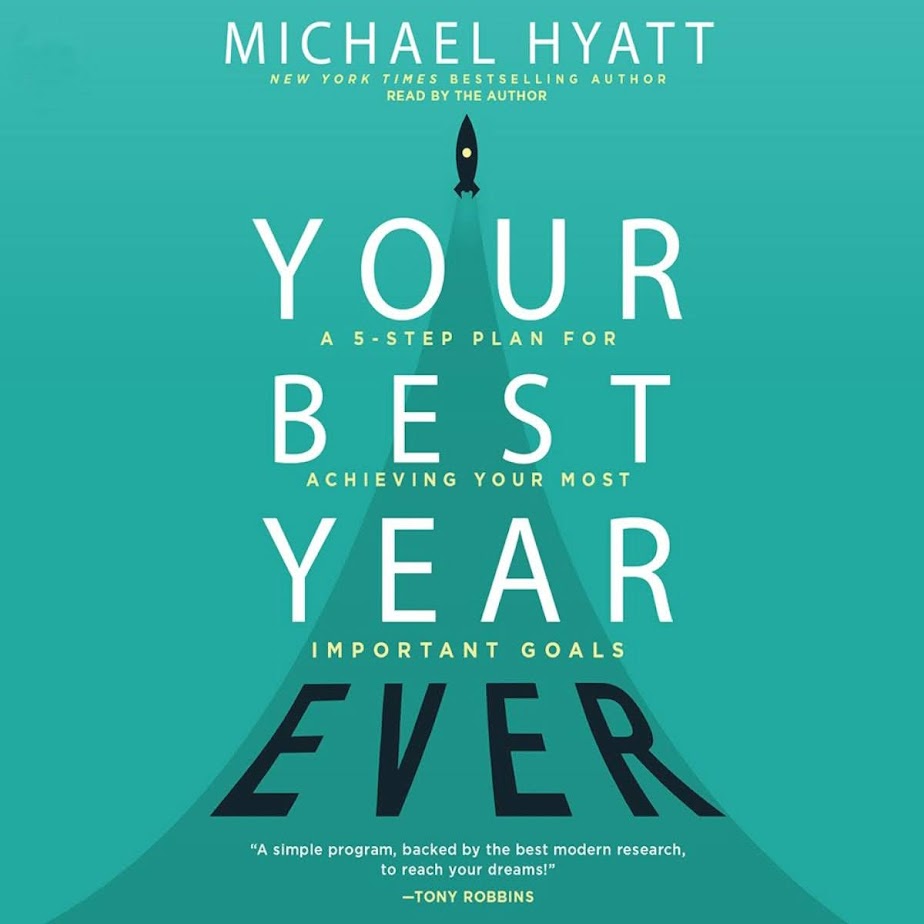In “Your Optimal Year Ever,” leadership authority Michael Hyatt reveals his technique to aid you in transforming your aspirations into attainable goals and then instructs you on embarking on the essential actions to realize them. You will discover how to operate from a mentality of plenty and establish the groundwork for triumph by readjusting your mindset. By utilizing the past as a blueprint for shaping the future, you will be on the path to your finest year ever.
Experience your finest year ever by converting aspirations into goals and subsequently goals into accomplishments.
Commencement
Many of us establish objectives for the New Year, kick off vigorously, but subsequently get sidetracked. This challenge is so prevalent that fitness centers vend yearly memberships to an excess of individuals than they can cater to, acknowledging that most will work out for under a month and never return.
Heather Kampf is familiar with getting diverted. In the 600-meter final at the 2008 Big Ten Indoor Track Championship, the triumphant runner stumbled and plummeted flat on her visage. Kampf then hoisted herself up off the ground and not only succeeded in completing the remainder of the race but surpassed everyone on the track to secure first place. This manuscript is about how to emulate just that: rise and propel yourself forward. Leadership authority Michael Hyatt introduces a goal-setting system that will aid you in evading common pitfalls and leveraging the dedication necessary to realize your objectives.
Maybe at present, you feel akin to Kampf after tumbling and discovering yourself at the back of the pack. Set that aside and envision having a groundbreaking year in which you fulfill all your objectives. Envision being more robust, financially stable, and in an affectionate relationship. Envision awakening thankful and content every day while feeling linked to a superior purpose. These possibilities are plausible with Hyatt’s system, grounded on five fundamental assumptions:
- Real life is multilayered and comprised of 10 interconnected spheres: spiritual, intellectual, emotional, physical, marital, parental, social, vocational, avocational, and fiscal.
- Every sphere holds significance.
- Progress commences when you get clarity on your status quo.
- You can enhance any of life’s spheres.
- Confidence, contentment, and satisfaction with life stem from individual expansion.
Hyatt’s method is fragmented into the five straightforward stages you will scrutinize in this summary. In stage 1, you will work on conquering uncertainties. Stage 2 is centered on attaining closure concerning the past. Stage 3 furnishes you with a seven-part framework to formulate goals that genuinely function. In stage 4, Hyatt introduces the most potent motivator he knows. Lastly, in stage 5, you integrate all the fragments in a manner that permits you to encounter your optimal year ever.

Believe in the Feasibility
Your thought patterns generate your encounters in life. If these patterns are affirmative, you live through favorable circumstances such as joy, individual gratification, and material accomplishments. If not, you undergo the converse and are discontent, unproductive, and dissatisfied. The uplifting news? You can amend thought patterns that don’t profit you. By focusing on enhancing your thoughts and beliefs, you can revolutionize your life.
Hyatt and his partner possessed a splendid Irish setter named Nelson who harbored one downside: He was an escape virtuoso who sprinted outdoors at every opportunity, exposing himself to perils from passing vehicles. The resolution was discovered in an electric boundary erected around the periphery of the household. Nelson sported a collar that emitted a warning vibration upon nearing the electric perimeter. Not only did Nelson learn to confine himself within the yard, but eventually, he didn’t even necessitate the collar. The fence was no longer the electric enclosure – it was Nelson’s mentality. This exemplifies how your beliefs configure your actuality.
Perhaps you resemble Nelson. Life has jolted you, so you desist, striving to avert the distress of defeat. You might contemplate, “Why should I strive for that position? I lack adequate expertise to impress them.” Or, “I yearn to participate in that marathon, but I’m excessively overweight.” The ruminations in your mind incarcerate you. Ponder on pilots who once reckoned it insurmountable to breach the sound barrier or runners who didn’t perceive the feasibility of running a four-minute mile. Nonetheless, these feats were feasible and ultimately achieved.
Reflect on the instance of two contrasting men, Charlie and Robert. Charlie feels victimized, grumbles about everything, and harbors suspicions constantly. In his estimation, everyone is unintelligent, and life is fixed. No wonder individuals do not relish his presence, and accomplishment perpetually eludes him. Evaluatively, Robert is supportive of his friends with a beaming countenance and abundant encouragement. He is generous, treats everyone amiably, and invests in the triumph of others. He receives reciprocity for his generosity and prospers in numerous aspects of life. What distinguishes these two men? One perceives existence from a standpoint of scarcity, and one from a perspective of affluence. Scarcity thinkers operate from a vantage of constraining beliefs, where minimal, if any, potentiality exists. Abundance thinkers function from a standpoint of emancipating, positive verities. What is your mindset?
Conclude the Past
Following limiting beliefs, the most frequent impediment to living your finest life is the inclination to brood over the past. It is intricate (if not insurmountable) to forge onward if you persist in gazing backward. Nevertheless, you can glean from the past in a manner that propels you toward fashioning a better future by engaging in what the U.S. military designates as an after-action review. This is a four-step stratagem that enables you to scrutinize the past and assimilate the lessons obtainable from it. Here is how to execute this process by reviewing your preceding year:
- Express what you aimed for. Delve into your objectives from the previous year. Did you harbor a significant aspiration, dream, or desire? Did you endeavor to initiate your own enterprise? Establish a committed relationship? Participate in a marathon?
- Acknowledge what happened in reality. While progressing through the former step, you likely discerned some disparities between your intentions and accomplishments. For instance, perchance you aspired to partake in a marathon but merely jogged around the block on a handful of occasions. Pose inquiries about any regrets you underwent to shed illumination on the present and future. Furthermore, question what you are proud of. What triumphs did you achieve over the past year? You ought to revel in your victories alongside examining your hardships.
- Educate yourself based on the encounter. What are the key life teachings discovered? What thoughts can you draw from the variations between your desires and actual outcomes? Can you pinpoint what was absent from your achievements last year? Were you able to stash more funds away? Invest more moments with your kin? These insights from the past can inspire you as you progress.
- Modify your actions. Despite collecting numerous teachings, they won’t be of much use if you don’t adapt your conduct accordingly. Utilize what you discern in your post-event evaluation to enhance your performance and your life as you go forward.
While traversing through the aforementioned steps, you may encounter remorse. Regret can be painful, but consider it a valuable lesson that can guide you in multiple ways. For instance, regret is educational as it offers insights to help you steer clear of future blunders. Additionally, regret can ignite a spark for change, pushing you to scrutinize how and why you deviated from your path. You can treat regret in one of two ways: as a hindrance or as a directive pointing towards your future. Perhaps your most significant frustration is directing you towards one of the biggest triumphs of your life.
Reflecting back can also breed appreciation. Studies have revealed that gratitude aids in accomplishing your objectives. It fosters hope, boosts your patience, and broadens potential responses to situations, shifting you to a state of abundance. For all these reasons, maintaining a gratitude document becomes extremely beneficial as you blueprint your future.
Construct Your Future
A promising future doesn’t materialize out of thin air, and you can’t aimlessly drift towards success. Thus, it’s crucial that you gain absolute clarity on your aspirations. The crux of clarity lies in morphing your aspirations and dreams into documented goals that adhere to seven parameters, easily remembered by the acronym SMARTER:
- Precise: Pinpoint exactly what you aim to achieve. For instance, “Grasp photography” is vague, while “Conclude a portrait photography course at the community center” is explicit.
- Quantifiable: Specify criteria that assist in gauging whether you’ve attained your goals. A definite target is imperative to assess progress.
- Action-oriented: Dynamic verbs aid in framing actionable goals. Contrast these objectives: “Enhance consistency in exercising” and “Jog for 30 minutes thrice a week.” The latter goal is more tangible.
- Daring: Formulating goals that carry certain risks can prevent stagnation. Risk propels you to achieve more as individuals thrive on challenges. Therefore, aim for ambitious objectives.
- Time-bound: Without deadlines, that crucial sense of urgency is lost. The intention of “Consume two books” is less effective than “Finish two books this month.”
- Enthralling: If a goal is inspiring and captivating, you’re more likely to attain it as you won’t lose interest.
- Pertinent: Your goals should harmonize with your values and the genuine necessities and obligations of your life. If you’re a working parent, your aspirations might differ compared to being youthful and single or retired.
Fulfillment ensues when you challenge yourself with goals that are both meaningful and daring. This also implies that the journey won’t always be smooth. However, that’s acceptable — comfort is overrated. If you desire to enhance your life, your objectives should push you beyond your comfort zone.
Discover Your Purpose
Commencing the pursuit of an exhilarating goal is relatively simple since motivation runs high in the initial phases. However, challenges intensify at some point, plunging you into the murky middle phase. This is where many individuals tend to give up. The prime approach to navigate this phase is by harnessing your motivation so that when the going gets tough, you keep forging ahead.
A winning strategy involves deeply connecting to why you yearn to achieve something. This underpins your progression towards the goal. When Hyatt aspired to participate in a marathon, he identified his incentives and penned them down. Initially, he was weary of being overweight and desired to attain the peak physical condition of his life. Furthermore, he aimed to acquire ample stamina and vigor to be his utmost self. This roster aided him in comprehending the stakes whenever he felt disinclined to run, fuelling his determination to hit the pavement nonetheless.
Post establishing a profound connection with your motivation, it’s crucial to master your driving forces as you move forward. You can adeptly manage them in four ways:
- Determine the appropriate incentive. Envision reaching the culmination of your goal and relishing a fulfilling reward.
- Be pragmatic about the requisite commitment. Acknowledge that cultivating new routines may demand more time than anticipated, and manage your anticipations accordingly to avoid demotivation.
- Infuse gamification into the process. Games serve as excellent motivators. When Hyatt resolved to enhance his water intake, he unearthed an application that displayed a digital plant flourishing every instance he logged his water consumption.
- Evaluate your progress. Instead of perpetually focusing on the distance left to cover, be sure to periodically assess how far you’ve already traversed.
Lastly, a voyage is always smoother with companions. Following the triumph of The Hobbit, J. R. R. Tolkien grappled with completing a sequel. He abandoned the manuscript multiple times. Yet, his confidant, the author and philosopher C. S. Lewis, urged him to persist. Tolkien mentioned that this encouragement was the sole reason he finalized his subsequent book, The Lord of the Rings. Enlisting the aid of a confidant or an expert can lead to knowledge, encouragement, accountability, and the impetus stemming from healthy competition.
Bring It to Fruition
Hitherto, you’ve imbibed numerous insights on devising strategies. Now, it’s time to delve into action. Realizing your goals necessitates taking the requisite steps. General George B. McClellan was appointed to steer the Union Army to triumph in the Civil War. Following a series of initial victories, there was widespread enthusiasm regarding his leadership and potential accomplishments. Alas, those hopes were shattered. Despite being adept at preparing his troops, McClellan faltered in combat. His proficient planning resulted in inadequate action. This shortfall induced his defeat against Robert E. Lee at Antietam. His narrative underscores a pivotal reality: Solely setting a goal is inadequate; achieving a goal demands action.
Executing action can be arduous, especially if you become entangled in excessive planning. A plan holds significance, yet excessive planning can evolve into a form of procrastination. Kickstarting by tackling the simplest task initially is the most effective approach. This initiates motion, uplifts your morale, and instigates momentum. Perhaps your aim is to complete a marathon, but transitioning from a sedentary lifestyle to daily running feels overwhelming. Initiate by dialing a coach or locating a virtual running club. Subsequent to taking that inaugural step, commit to traversing all the steps leading to your objective.
Upon commencing progress towards your goal, you may discover lingering difficulty in taking action. Hyatt utilizes activation cues to counter this hurdle. These triggers set the stage for action, aiding in advanced planning to avert impediments and sustain momentum. For instance, when Hyatt encountered difficulty rising from bed at six in the morning for exercise, arranging his gym attire the previous night nudged him forward upon the alarm’s chime. This form of proactive planning can assist you in surmounting obstacles and sustaining progress.
Lastly, establishing a regular goal evaluation process is imperative. Research indicates that individuals who jot down theirAchievers who set objectives and document their advancement have a greater capacity to assess what impedes them and how to conquer it. An effective tactic is to review a record of your objectives every day. This process keeps them recent in your memory and enables you to link your objectives to everyday duties. A more in-depth assessment on a weekly basis aids in keeping you emotionally and intellectually engaged. This is an opportune moment to reassess your reasons for staying inspired and to grasp what responsibilities lie ahead in the upcoming week. Lastly, plan for a thorough evaluation every quarter. During a quarterly evaluation, make sure to celebrate any progress achieved, adjust the objective if necessary, and reaffirm your commitment.
If a goal no longer aligns with you, feel free to delete it. Absolutely, you have the liberty to discard a goal. This is your life, and if you realize that a goal no longer contributes to making this your best year ever, you have the freedom to release it.
Conclusion
Embrace Hyatt’s five-phase system and convert your aspirations into reality. Begin by addressing any restricting beliefs you may harbor and enhance your mindset towards abundance. Utilize the post-action evaluation to glean insights from the past, remembering that regret could serve as a propeller towards progress and even indicate the path you need to follow. Establish SMARTER objectives and make strides towards those targets by delving deeply into the reasons you established them initially. Subsequently, take the necessary actions to achieve them – taking action proves crucial. If you need assistance to stay on course, utilize activation triggers and establish a routine objective review process.
Transforming your aspirations and dreams into attainable goals and striving towards them is demanding, but ultimately leads to a much more fulfilling life. It is time to experience your finest year to date!
Michael Hyatt
Michael Hyatt is a renowned authority in leadership and the founder of the leadership development company Michael Hyatt & Company. He is the co-author of Living Forward (co-written with Daniel Harkavy) and the bestseller Platform: Get Noticed in a Noisy World.
Assessment
This manual is a self-improvement guide for individuals aiming to reach their most crucial objectives and lead a purposeful life. The writer, Michael Hyatt, is a bestselling author, presenter, and entrepreneur who has aided countless individuals in attaining their full potential. He shares his proven strategy for establishing and reaching goals, which he terms the Five Phases to Accomplishing Your Most Important Objectives. These are:
- Step 1: Believe in the Feasibility. This phase requires overcoming the limiting beliefs and adverse sentiments that hinder us from pursuing our goals. The author elucidates how to recognize and challenge these beliefs, and how to supplant them with positive affirmations and thankfulness.
- Step 2: Conclude the Past. This phase entails reviewing the prior year and drawing lessons from our achievements and shortcomings. The author offers a framework for carrying out a year-end evaluation, which enables us to toast our victories, acknowledge our misfortunes, and pinpoint our key takeaways.
- Step 3: Create Your Future. This phase involves formulating a vision for our future and setting SMARTER goals that are in sync with it. The author explains the utilization of his goal-setting model, which helps us to delineate our goals to be specific, quantifiable, executable, daring, time-bound, energizing, and pertinent.
- Step 4: Uncover Your Why. This phase encompasses discovering the impetus and intention behind our goals, aiding us in remaining devoted and overcoming barriers. The author shows how to draft a compelling goal declaration, encompassing the gains, the expenses, and the evolution following achievement of our goal.
- Step 5: Bring It to Pass. This phase involves taking action and progressing towards our goals. The author dispenses his top practices and instruments for strategizing, prioritizing, scheduling, monitoring, evaluating, and refining our goals. Furthermore, he advises on handling common obstacles such as fear, distraction, procrastination, resistance, and exhaustion.
I discovered the manual to be extremely beneficial and motivating. The author possesses a lucid and captivating writing style that renders the manual effortless to peruse and comprehend. He also infuses numerous instances and anecdotes from his own life and those of other successful individuals to illustrate his points and render them relatable. I appreciated the equilibrium struck between the theoretical and practical facets of goal-setting, as well as the provision of actionable steps and drills for each phase of the process.
The manual is not only enlightening but also empowering. It urges us to assume control of our lives and contentment, challenging us to achieve our loftiest objectives. It also serves as a reminder of our potential and capabilities, celebrating our accomplishments and evolution. It is a manual that can aid anyone seeking to enhance their personal, professional, or spiritual life.
On the whole, I opine that this manual is a valuable tool for anyone desiring to grasp how to realize their most crucial objectives. It is not a manual that dictates what we should do but rather one that demonstrates what we can accomplish. It is a manual that will prompt us to think and act differently. It is a manual that will propel us to experience our finest year to date.


